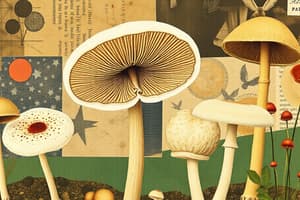Podcast
Questions and Answers
What characteristic differentiates yeast from molds?
What characteristic differentiates yeast from molds?
- Yeasts are multicellular while molds are unicellular.
- Yeasts reproduce by spores while molds reproduce by budding.
- Yeasts are unicellular while molds are multicellular. (correct)
- Yeasts have chitin in their cell walls while molds do not.
Which substance is a major component of the cell wall in fungi?
Which substance is a major component of the cell wall in fungi?
- Chitin (correct)
- Cellulose
- Peptidoglycan
- Lignin
Candida albicans exhibits which of the following characteristics?
Candida albicans exhibits which of the following characteristics?
- It is a unicellular fungus that does not bud.
- It has pseudohyphae and is gram positive. (correct)
- It is a true mold.
- It reproduces exclusively by spore formation.
Fungi can be classified based on their morphology. Which of the following is NOT a classification of fungi?
Fungi can be classified based on their morphology. Which of the following is NOT a classification of fungi?
Which of the following fungi primarily reproduce via budding?
Which of the following fungi primarily reproduce via budding?
How do most fungi obtain their nutrients?
How do most fungi obtain their nutrients?
What are the two main types of fungi based on their cellular organization?
What are the two main types of fungi based on their cellular organization?
Which of the following statements about fungal infections is true?
Which of the following statements about fungal infections is true?
What distinguishes septate hyphae from aseptate hyphae?
What distinguishes septate hyphae from aseptate hyphae?
Which of the following fungi exhibits dimorphism?
Which of the following fungi exhibits dimorphism?
What is the primary method of reproduction for filamentous fungi?
What is the primary method of reproduction for filamentous fungi?
What type of spores are formed within a sac during asexual reproduction?
What type of spores are formed within a sac during asexual reproduction?
Which of the following describes a characteristic of the Deuteromycota classification?
Which of the following describes a characteristic of the Deuteromycota classification?
At which temperature does the yeast form typically develop in dimorphic fungi?
At which temperature does the yeast form typically develop in dimorphic fungi?
Which of the following is a characteristic feature of conidiospores?
Which of the following is a characteristic feature of conidiospores?
Which fungus is known for causing opportunistic infections in AIDS patients?
Which fungus is known for causing opportunistic infections in AIDS patients?
Flashcards
Mycology
Mycology
The study of fungi, including yeasts and molds.
Yeast
Yeast
Unicellular fungi that reproduce by budding.
Mold
Mold
Multicellular, filamentous fungi that reproduce by spores.
Fungal Cell Wall
Fungal Cell Wall
Signup and view all the flashcards
Fungi
Fungi
Signup and view all the flashcards
Yeast-like fungi
Yeast-like fungi
Signup and view all the flashcards
Dimorphic Fungi
Dimorphic Fungi
Signup and view all the flashcards
Pseudohypha
Pseudohypha
Signup and view all the flashcards
Hyphae
Hyphae
Signup and view all the flashcards
Septate hyphae
Septate hyphae
Signup and view all the flashcards
Aseptate hyphae
Aseptate hyphae
Signup and view all the flashcards
Mycelium
Mycelium
Signup and view all the flashcards
Conidia
Conidia
Signup and view all the flashcards
Reproduction by budding
Reproduction by budding
Signup and view all the flashcards
Deuteromycota
Deuteromycota
Signup and view all the flashcards
Study Notes
Mycology: Study of Fungi
- Mycology is the study of fungi, including yeasts and molds.
- Yeasts are unicellular, rounded fungi.
- Molds are multicellular, filamentous fungi.
- Fungi reproduce via budding (yeasts) or spores (molds).
- Fungi have rigid cell walls containing chitin, glucan, mannans.
- Cell membranes contain ergosterol.
- Fungi are eukaryotic organisms with a nucleus, nuclear membrane, endoplasmic reticulum, and mitochondria.
Characteristics of Fungi
- Fungi are important as plant, human, and animal pathogens.
- Over 70% of plant diseases are fungal.
- Many fungi are saprophytes (consuming dead matter).
- Other fungi are parasites.
- Most fungi are multicellular, but yeasts are unicellular.
- Fungi are aerobes or facultative anaerobes.
- Cell walls are primarily composed of chitin.
- Many human fungal infections are nosocomial (hospital-acquired) or occur in immunocompromised individuals (opportunistic infections).
Morphological Classification of Medically Important Fungi
- Yeasts: Unicellular, non-filamentous, oval/spherical cells. Reproduce by budding.
- Example: Candida albicans (yeast-like), Cryptococcus neoformans (true yeast, capsulated).
- Yeast-like fungi: Grow partly as yeast cells and partly as elongated cells resembling hyphae (pseudohyphae). Reproduce by budding.
- Example: Candida albicans
- Molds/Filamentous fungi: Multicellular, filamentous. Form a mycelium composed of hyphae. Reproduce via spore formation.
- Identified by appearance, colony characteristics, and spore types.
- Examples: Aspergillus, Penicillium, dermatophytes.
- Hyphae can be septate (divided by cross-walls) or aseptate (uninterrupted).
- Mycelium is the visible filamentous mass.
- Penicillium: Brush-like arrangement of conidia, initially velvety/white, later powdery/blue-green.
- Aspergillus: Green-colored colonies on SDA/PFA, conidiophores, sterigmata, conidia visible with Lactophenol Cotton Blue stain.
- Dimorphic fungi: Can exist as both molds and yeasts, depending on growth conditions.
- Mold form produces hyphae; yeast form reproduces by budding.
- Primarily infect the lungs.
- Dimorphism often temperature-dependent (e.g., yeast at 37°C and mold at 25°C).
- Examples: Blastomyces dermatitidis, Coccidioides immitis, Histoplasma capsulatum, Sporothrix schenckii, Penicillium marneffei, Paracoccidioides brasiliensis.
Reproduction and Life Cycle of Fungi
- Yeasts and yeast-like fungi reproduce by budding.
- Filamentous fungi reproduce asexually (fragmentation of hyphae).
- Spores are for both sexual and asexual reproduction.
- Asexual spores (e.g., conidiospores, chlamydospores, sporangiospores) are produced by aerial hyphae.
- Sexual spores are produced by fusion of nuclei from opposite mating strains.
Divisions of Fungi (Systematic Classification)
- Deuteromycota (Fungi Imperfecti): Unknown to produce sexual spores. Reproduce asexually.
- Example: Candida albicans (vaginal yeast infections; opportunistic in AIDS), Malassezia furfur, Sporothrix schenckii.
Studying That Suits You
Use AI to generate personalized quizzes and flashcards to suit your learning preferences.




